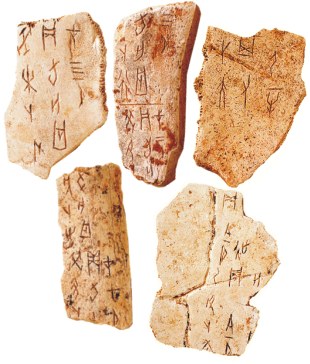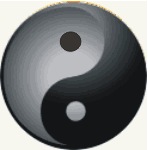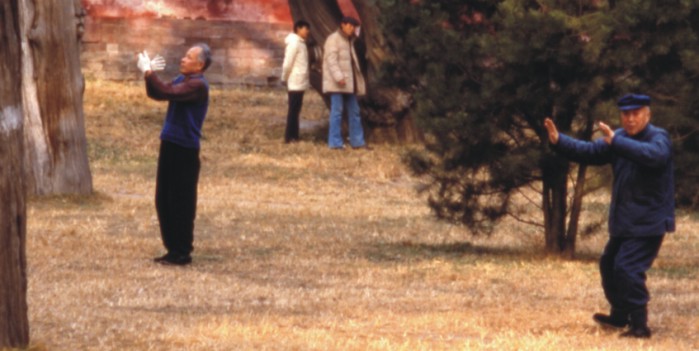
Home - Intro - Table of Contents - Hinduism - Buddhism - Islam
Judaism - Christianity - Aaron's Travels/Studies - Bibliography - Index - Bookstore
Please enjoy pictures and excerpts from pages 32 and 36-37 of my
book. Since I spent months backpacking mainland China and took various classes
at the University, the section on China is a bonus section included with the major world religions. Many people are aware of
Chinese spirituality. The Yin-Yang symbol and martial arts pervade aspects of
western culture. Feel free link to other sections. Enjoy!
_________________________________

Chinese always sought the realm or world of Great Harmony. History
proved that when this Great Harmony was out of balance change was required. The
earliest historic records and development of writing stemmed from the Shang
dynasty that ruled portions of China from approximately 1600-1050 BCE. Beyond
perfecting bronze casting, they left numerous written records on tortoise shells
and cattle bones. At this time written language was primarily reserved for
religious purposes. Although power was recognized in their ancestors or the
forms and forces of nature, supreme authority resided in Shang Ti. Shang (as in
the name of the early dynasty) means “upper, topmost, or supreme.” Ti refers to
ancestors in the sense of “royal ancestors.” Translations of Shang Ti vary from
“God” to “Lord on High.” My use of “Divine Ancestor” is a more literal
translation that recognizes the source of all life.
Types of prayers,
including those with questions, were often written and presented to God (Shang
Ti). For example, if the emperor or others sought direction on issues relating
to marriage, childbirth, hunting, agriculture, or war, a type of prayer request
was written, often on a cow’s shoulder bone. At times the bones were placed upon
a designated altar. The altar’s fire would cause cracks. These cracks, in turn,
could be interpreted by their association with the written Chinese characters.
Cracks might provide guidance by touching and dividing particular words or
pharses. The easiest questions to answer were in the form of yes or no. For
example, a king might wonder if it was auspicious to go to battle, hunt, or
marry at a particular time. All of these ancient bones (even those without any
cracks) are commonly referred to as “oracle bones.” ...
_________________________________

The Tao or Way of heaven and earth manifests two aspects, a
spiritual and a practical. Although exhibiting one and the same essence, the
spiritual Way unites the heart and mind in a mystical union words could hardly
define. Mystical aspects often defied conscious reasoning, yet seem present in
acts of morality, love, charity, and kindness. ...
Translations of the
mystical poems of the Tao Te Ching are based on the early pictograms that
developed into the traditional characters of the Chinese language. The fourth
poem provides a nice introduction to spiritual relationships between the
individual, ancestors, God, and the Tao.
The Way (Tao) includes each individual vessel
that connects
to the eternities.
Its divine essence is the vast depths
producing all
ancestors now and in the future;
it makes truths comprehensible
resolves
separateness,
substantiates each insight,
for its eternal essence always
gives birth.
All able to embody these understandings,
will know the
divinity of the great God
and how eternity continues.(6)
[footnote #6] The earliest existing copy of the Tao Te Ching stems from 200 BCE. As the Chinese characters were less developed, interpretation is required for translation. I translated chapter four relying on the connection of numerous dictionaries (many available on the www), along with other translations. Some translators deleted Chinese characters (one version deleted 12 of the 42 characters), or added many additional words to elaborate their understandings. It may be noted that I referred to the translations of the Tao Te Ching by: R.B. Blakney, H.G. Creel, G. Feng, C. Muller, J. McDonald, S. Mitchell, C. Hansen, P. Merel, S. Rosenthal, J. Legge, A. Crowley, S. Beck, T. Byrn, T. Ganson, and T. McCarroll.
_________________________________
[The China section continues with information concerning the "Oracle Bones," the development of the Chinese I-Ching, the developments and spread of Buddhism in China (such as Ch'an/Zen Buddhism), and T'ai-chi-chuan. Discover quotes by Mao Tse-tung, Confucius, and an ancient Chinese classic, the Shih Ching, a "Scripture of Prayers."]

Home - Intro - Table of Contents - Hinduism - Buddhism - Islam
Judaism - Christianity - Aaron's Travels/Studies - Bibliography - Index - Bookstore